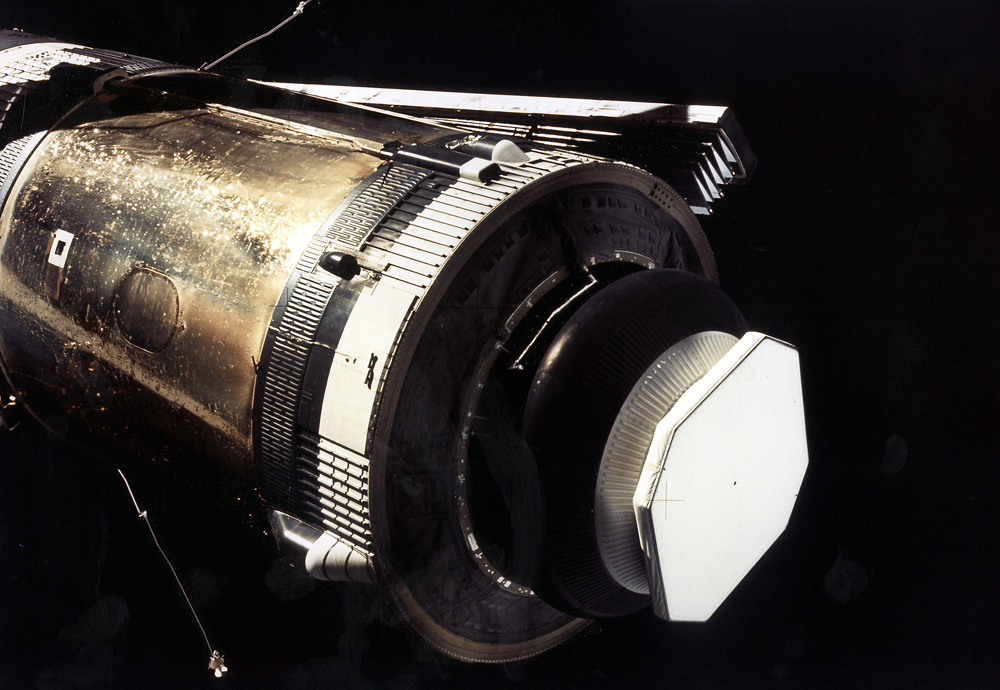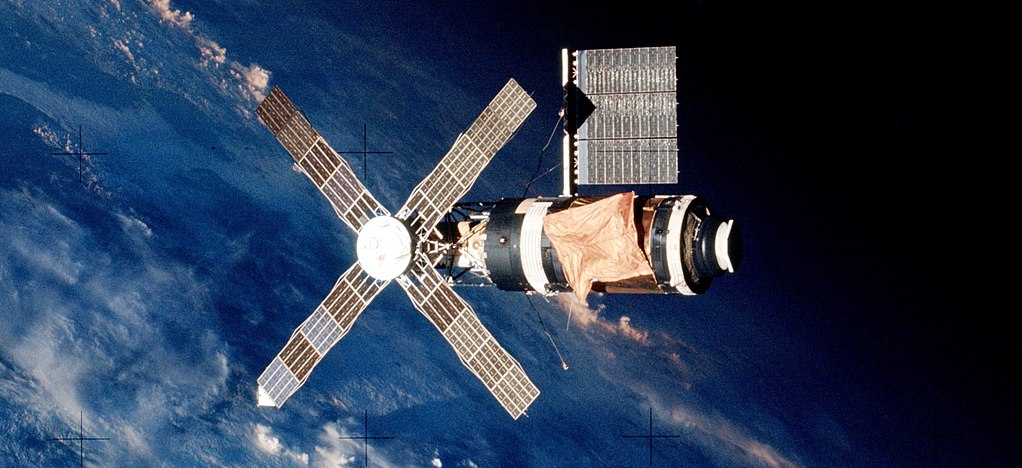The first manned mission to Skylab launched on May 25th 1973, carrying astronauts Pete Conrad, Joe Kerwin, and Paul Weitz on a planned 28 day stay on the United States first space station. The first thing the crew would need to do, however, was make Skylab livable.
Skylab was heavily damaged during its launch on May 14th, 11 days earlier. In that time, engineers used the information presented to them to work out a solutions to the two main problems – overheating of the station in the sunlight, and freeing one remaining solar panel which was apparently functional, but jammed by debris.
On May 26th, the Skylab 2 crew reached the station and conducted a fly around examination, being the first people to see the extent of the damage and finally being able to know for sure what needed to be done to protect the station and free the damaged solar wing.
The stations micro meteoroid shield was indeed gone completely, as mission control had suspected. The sun-facing side of the station had actually begun to blacken from the heat, the gold insulation foil surrounding the Orbital Workshop not having been designed for prolonged, direct sun exposure. The surface was pitted heavily by micro meteor debris, but on a whole was still physically sound.
The damaged solar wing was indeed held down by straps of metal, as was suspected. The other solar wing was completely missing, which had been suspected but wasn’t known for sure. Even with the other solar wing freed, Skylab would not be able to operate with the maximum designed power capacity it was built for, but it would be enough to allow for later missions to be successful.
The Apollo CSM was soft docked (only partially connected) to Skylab for 49 minutes, giving the crew time to eat before beginning the first repair attempt – freeing the suck solar wing. The Apollo CSM was maneuvered beside Skylab, and began the attempt – Pete Conrad would keep the Apollo CSM near Skylab, Skylab itself would be kept stable by ground control, and Paul Weitz would stand out of the hatch of the Apollo spacecraft and attempt to cut the debris holding the wing down using a hooked pole brought up as part of the tools for repairing the station. Joe Kerwin would hold Weitz’s legs during this process.

This image shows the stuck solar wing, on the upper right. The lower left shows the area where the missing solar wing should have been.
Yes, I’m quite certain it would look as absolutely crazy as it sounds, but it could have worked. Sadly, it didn’t, and rather than waste resources continuing to try this method, it was decided to go ahead and dock with the station and focus on the sunshade issue.
The crew docked to the station once again but found hard docking – forming a solid connection to the station – wasn’t happening. The capture latches on the Apollo docking system were failing to operate. After 8 failed attempts the crew donned their pressure suits, took apart part of the docking system, and tried again. It worked this time, and Apollo was properly docked with Skylab, allowing crew transfer.
Once onboard, the parasol-like sunshade that had been devised to be deployed through a scientific airlock on the sun-facing side of the station was installed. It worked, and temperatures began to decrease in the station. It stayed a bit warm, but it was comfortable enough.
2 weeks later, on June 7th 1973, Pete Conrad and Joe Kerwin spent 3 hours 25 minutes outside the space station working to free the stuck solar wing. Due to the mechanics of working in zero gravity, it was a hell of an effort. While they had practiced on Earth in a neutral buoyancy tank – basically a giant pool with a simulation of Skylab in it, this still wasn’t quite like operating in orbit.
After finding a place to secure his tether, Joe Kerwin was able to finally snap the metal holding the solar wing down. For a moment, nothing. Then, the solar wing deployed, somewhat violently, sending Conrad and Kerwin tumbling out into space – stopped only by the safety tethers holding them to the station.
The solar wing was free. Skylab had power, and had a modest protection from the Suns heat with the parasol covering the exposed Orbital Workshop, but it was enough – Skylab was operational. The repairs had worked.

Skylab following the repairs done on the Skylab 2 mission – the one freed solar wing and the parasol sunshade are visible, as well as the solar panels of the Solar Telescope.
Other minor repairs were made to the station and normal scientific experiments and observations were made by the Skylab 2 crew over the 28 day mission, but I find the effort made to repair the station while on orbit, with it in an unknown but clearly damaged state, were amazing. I hope to be able to cover these efforts in better detail between now and the 50th anniversary of the mission in 2023. We will see what happens then, but for now, some footage of the EVA where the solar wing was freed. It really lets you hear and see just how things were up there.
Enjoy.



1 Comment
Add a Comment